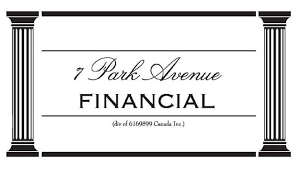|
Asset Based Business Line of Credit: Financing That Grows With You
The Smart Alternative to Bank Loans
YOUR COMPANY IS LOOKING FOR ASSET FINANCE AND ASSET-BASED LINE OF CREDIT FINANCING!
ASSET-BASED FINANCING / TYPES OF ASSET-BASED FINANCING
UPDATED 06/26/2025
You've arrived at the right address! Welcome to 7 Park Avenue Financial
Financing & Cash flow are the biggest issues facing businesses today
ARE YOU UNAWARE OR DISSATISFIED WITH YOUR CURRENT BUSINESS FINANCING OPTIONS?
CONTACT US
CALL NOW - DIRECT LINE - 416 319 5769 - Let's talk or arrange a meeting to discuss your needs
EMAIL -
sprokop@7parkavenuefinancial.com

"The art of business is converting assets into cash at a profit." - Henry Ford
7 Park Avenue Financial originates business financing solutions for Canadian Businesses. We offer asset based revolving lines of credit and working capital solutions – Save time, and focus on profits and business opportunities
7 Park Avenue Financial: “Canadian Business Financing with the intelligent use of experience”
Understanding the Asset-Based Revolving Line of Credit
Asset finance and revolving credit lines that can generate cash flow/working capital for businesses are almost always a top priority for Canadian business owners and financial managers.
Your business assets hold untapped potential that could power your next growth phase.
Could your company benefit from an asset-based loan using this method of financing, which often includes a covenant-light structure to provide greater flexibility? We think so; let's dig in.
Breaking Free from Cash Flow Constraints
Cash flow gaps devastate businesses daily.
Traditional banks demand perfect credit and endless paperwork while your opportunities vanish. Your valuable assets sit idle as creditors demand payment.
Asset based business lines of credit transform your inventory, receivables, and equipment into immediate working capital. Access funds within days, not months, using what you already own.
Transform Business Assets Into Working Capital
Many Canadian businesses struggle with unpredictable cash flow cycles, watching growth opportunities disappear due to limited working capital.
The stress of meeting payroll, managing inventory, and funding expansion can keep Canadian business owners awake at night.
Let the 7 Park Avenue Financial team show you how Asset-Based Revolving Lines of Credit convert your receivables, inventory, and equipment into immediate working capital, providing the flexibility your business needs to thrive.
3 Uncommon Takes on 'ABL':
-
Using an Asset-Based Revolving Line of Credit can improve supplier relationships by enabling early payment discounts
-
This financing tool can serve as a hedge against interest rate fluctuations compared to traditional term loans
-
It can be strategically used to acquire competitors' assets during market downturns - limits are almost always significantly higher than traditional operating facility advances from conventional lending criteria
Did You Know
-
78% of businesses using asset-based lending report improved cash flow
-
Average advance rates: 85% on receivables, 60% on inventory
-
Market growth: 12% annually in Canadian asset-based lending
-
65% reduction in cash flow gaps reported
-
92% renewal rate among established borrowers
WHAT IS ASSET-BASED LENDING ('ABL')
Independent finance firms are the real origin of asset credit lines - they are, therefore, 'non-bank' in nature and focus on funding your company's assets via the maximum loan available to your business.
Entering into this type of facility should always be done with the expertise of a business financing advisor, your accountant, and, in some cases... your bank!
Executing ABL transactions involves originating, structuring, and closing these transactions for a diverse client base. More on that last one later.
ASSET-BASED LOANS IN CANADA
The most important thing you can do when contemplating such a transaction is to understand the financial offering and how the Canadian marketplace works.
Asset finance or asset-based lines of credit allow your Canadian firm to maximize the utilization of asset values related to three possibly essential components of its asset base.
Those components?
(In some cases, asset lending values on real estate can be blended into your credit line)
So why does this facility work differently than unsecured loans via a traditional chartered bank line of credit under traditional commercial banking in Canada?
The answer?
Higher borrowing/margin limits via a higher loan-to-value ratio for growth financing funding!
What is meant by that? Your firm simply can leverage higher borrowing, when and if necessary, against those asset classes we have just mentioned.
In the case of receivables, 90% of receivables are less than 90 days. In the case of inventory, it involves understanding the true value of your inventory on an ongoing basis, which includes your costs and ultimate marketability.
Lenders often depend on the net orderly liquidation of inventory and accounts receivable to determine financing amounts.
The true cost benefit of an asset-based line of credit facility is that you use the facility when you want and to what extent you want - from a cost perspective, that equates to paying for only what you use. Lenders generally use the net orderly liquidation value (NOLV) as part of their appraisal methods to determine the inventory value companies can finance.
ASSET-BASED LENDING RATES
Asset finance and asset-based lines of credit tend to traditionally be more expensive than banks' lines of credit due to higher interest rates. Let's just understand the basics of that. Currently, banks pay between one or two percent, perhaps three percent to depositors in Canada.
If they can lend those funds to your firm at 200-300 basis points more—i.e., 5 or 6% rates, the banks consider that a winning proposition.
But they want to be secure on that transaction, so that involves your guarantee, lower margining of the asset, and strict rules and covenants around ratios, operating performance, etc.
Independent finance firms borrow from banks or raise capital themselves - they, therefore, mark up those funds, so in general, asset finance and asset-based lines of credit cost your firm more.
But if your firm can grow revenues and increase profits with a higher borrowing cost, is that not okay? We think the evidence suggests that proper consideration of an asset finance and asset-based line of credit warrants significant merit.
The bottom line is as follows:
You should consider asset-based facilities if your company is growing or has growth opportunities that need good financing solutions. Bank lending is still difficult for many small and medium-sized firms to access.
Case Study: Manufacturing Success Story
Company: Mid-sized Canadian automotive parts manufacturer
Challenge: Needed $500,000 working capital to fulfill large OEM contract but traditional bank required 60-day approval process
Solution: Asset based business line of credit secured against inventory and receivables
Results:
-
Approved in 8 business days
-
Accessed $750,000 credit line to draw funds based on asset values
-
Successfully completed contract generating $1.2M revenue
-
Established ongoing relationship for future growth financing
-
Reduced cash-to-cash cycle by 18 days through improved cash flow management
KEY TAKEAWAYS
-
Borrowing Base Calculations determine your available credit by evaluating eligible assets
-
Monthly Collateral Reporting ensures continuous access to working capital
-
Asset Eligibility Requirements define which assets qualify as security
-
Advance Rates vary by asset type and quality
-
Covenant
-
Compliance maintains your borrowing privileges
CONCLUSION - ASSET-BASED LINES OF CREDIT
Investigate asset finance, determine your needs -
Call 7 Park Avenue Financial, a trusted, credible and experienced business financing advisor, to ensure your Canadian asset facility and financing solution can help your firm grow revenues and profits.
FAQ: FREQUENTLY ASKED QUESTIONS / PEOPLE ALSO ASK / MORE INFORMATION
What is asset-based lending?
Asset-based lending, also known as asset-based financing, is a financing agreement that secures a business's collateral/physical assets via credit and term loans, a business line of credit, or, in some cases, a term loan. This method of financing a business utilizes assets such as accounts receivable, inventories, fixed assets/equipment, and, in some cases, commercial real estate.
More liquid assets, such as receivable financing, provide more financing, providing valuable working capital financing to fund day-to-day operations. If a borrower defaults, the specific assets secured under the financing are the collateral for the loans or lines of credit. Other assets, such as real estate or intellectual property, can be financed under the same facilities.
What is an asset line of credit?
Asset-based lending is a business revolving line of credit that is typically secured via A/R, inventories, and fixed assets/equipment. The asset based lender margins these assets to determine a borrowing base under which the company can borrow to improve the company's cash flow.
What is the difference between a loan and a line of credit?
A business line of credit typically has a credit limit attached to the facility—funds are paid back as the facility revolves and fluctuates according to the business's cash flows. Term loans are for the purchase of assets and have fixed payments or installments.
Is factoring accounts receivable a form of lending?
Factoring is a form of commercial financing for a company's accounts receivable under the umbrella of asset-based lending. It is a monetization of receivables on the balance sheet—it is not a loan/term loan per se. As businesses generate sales and issue invoices via the accounts receivable process, a firm can leverage cash flow as it requires.
How does an Asset-Based Revolving Line of Credit provide flexibility?
-
Asset lending offers Access to funds as needed, pay only for what you use
-
Credit line grows with your business
-
No fixed monthly payments
-
Seasonal adjustments available
-
Multiple asset types are accepted
-
Refinance existing debt
What makes this financing option better than traditional loans?
-
Higher advance rates available
-
No fixed payment schedule
-
Credit line grows with sales
-
Faster approval process
-
Lower personal guarantees required
How can this improve my cash flow management?
-
Immediate access to working capital
-
Reduced payment pressure
-
Better supplier terms possible
-
Seasonal flexibility
-
Improved forecasting ability
What businesses benefit most from this type of financing?
How does the application process work?
What documentation is required for approval?
-
Financial statements
-
Asset listings
-
Tax returns
-
Business plans
-
Bank statements
How long does approval typically take?
-
Pre-qualification: 24-48 hours
-
Due diligence: 1-2 weeks
-
Final approval: 2-3 weeks
-
Documentation: 1 week
-
First funding: 24-48 hours
What ongoing requirements exist?
-
Monthly financial reporting
-
Regular collateral updates
-
Annual reviews
-
Borrowing base certificates
-
Covenant compliance
What costs are involved?
How secure is this type of financing?
-
Fully regulated
-
Bank monitored
-
Asset protected
-
Insurance required
-
Compliance overseen
What determines my credit limit?
-
Asset quality and value
-
Historical performance
-
Industry type
-
Management experience
-
Financial strength
How does the revolving feature work?
-
Continuous access to funds
-
Automatic credit restoration
-
Payment flexibility
-
Usage-based costs
-
Dynamic limit adjustments
What differentiates asset-based from traditional lending?
Citations
- Canadian Bankers Association. "Alternative Lending in Canada: 2024 Market Report." https://www.cba.ca
- Business Development Bank of Canada. "Working Capital Solutions for Growing Businesses." https://www.bdc.ca
- Industry Canada. "Small Business Financing Statistics and Trends." https://www.ic.gc.ca
- Commercial Finance Association. "Asset-Based Lending Market Analysis." https://www.cfa.com
- Financial Consumer Agency of Canada. "Business Credit and Financing Guide." https://www.fcac-acfc.gc.ca
- 7 Park Avenue Financial." ABL Lending And Current Asset Based Loan Rates Make Impossible Financing Possible." https://www.7parkavenuefinancial.com/abl-lending-asset-based-loan-rates.html

' Canadian Business Financing With The Intelligent Use Of Experience '
STAN PROKOP
7 Park Avenue Financial/Copyright/2025

ABOUT THE AUTHOR: Stan Prokop is the founder of 7 Park Avenue Financial and a recognized expert on Canadian Business Financing. Since 2004 Stan has helped hundreds of small, medium and large organizations achieve the financing they need to survive and grow. He has decades of credit and lending experience working for firms such as Hewlett Packard / Cable & Wireless / Ashland Oil
|